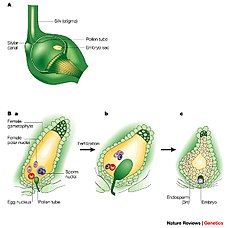In the year 1898, Sergius Nawaschin seconded a few months later by Leon Guignard(1899) suggested that fertilization is double in Lilium martagon and Fritillaria tenella. It was then believed that indeed it occurs in flowering plants.
This is a complex fertilization mechanism that occurs in angiosperm (flowering plants). It involves the joining of a female gametophyte (megagametophyte otherwise called the embryo sac) with two male gametes. The pollen grain reaches the ovary and thus enters the ovule through the micropyle, further entering one of the synergids through the filiform apparatus which is present at the micropolar part of the synergids.
When the pollen tube enters one of the synergids, it releases the two gametes into the cytoplasm. For double fertilization to occur, one of the male gametes goes towards to egg cell fusing with its nucleus resulting in the formation of a diploid cell, the zygote.
The other male gamete heads towards the two polar nuclei situated in the central cell fusing with them to produce a triploid primary endosperm nucleus which involves the fusing of three haploid nuclei (triple fusion). This phenomenon is called double fertilization since it involves the two types of fusion which are syngamy and triple fusion that both occur in an embryo sac and is unique to angiosperms. The central cells undergo triple fusion to form the primary endosperm cell (PEC), thus developing into an endosperm while the zygote becomes the embryo.
This type of fertilization has its unique significances which include;
- The involvement of both the male gametes produced by the pollen grain has the possibility of poly-embryology thus increased chances of survival of the new plant.
- There are two types of fusion, leading to two new products.
- The diploidy in the life cycle is restored where the diploid zygote develops into an embryo, consequently producing a new plant.
- The developing embryo gets nourishment from the second fertilization product, the triploid primary endosperm nucleus (PEN) which develops into a nutritive tissue called endosperm.
- Due to double fertilization in flowering plants, their seeds are more viable.
- It helps in energy conservation in angiosperms. The plant does not allocate energy-intensive resources towards an egg that eventually will not fertilize making it less fit since the endosperm formed by the fusion of the two polar nuclei and sperm only begins to develop and thus stores nutrients after fertilization by a sperm cell.
